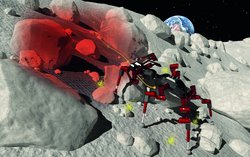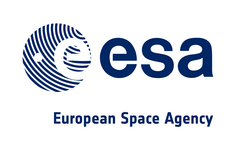ANT
Autonomous Non-wheeled all-Terrain rover
Navigation system for legged robots for traversing unconsolidated, inclined, and rugged terrain.
| Duration: | 27.01.2021 till 26.10.2022 |
| Donee: | German Research Center for Artificial Intelligence GmbH |
| Sponsor: | ESA |
| Grant number: | ESA AO/1-10289/20/NL/RA |
| Partner: |
Italian Institute of Technology |
| Application Field: | Space Robotics |
| Related Projects: |
Entern
Environment Modelling and Navigation for Robotic Space-Exploration
(10.2014-
12.2017)
VIPE
Exploration in terrain difficult to access (e.g. Valles Marineris) using visual and proprioceptive data.
(05.2015-
06.2018)
|
Project details
The objective of the activity is to develop the ANT navigation system for legged robots. It will be able to perceive the terrain, to plan a path to a desired goal and to control the path execution while traversing unconsolidated, inclined, and rugged terrain. A modular generic approach is being developed to exploit the potential of robots with four (quadrupeds) as well as with six legs (hexapods).
Videos
ANT: Navigation and guidance system enables robots to traverse rough, inclined, unconsolidated terrains. Final tests.

The work on the ANT guidance, navigation, and control system for future planetary exploration walking system has finished. The final tests proofed its capabilities on unconsolidated, unstructured, and inclined terrains. The visual foothold adaptation can rely on a high-frequent and drift-free pose estimation and on an up-to-date map. Therefore, contact-information are additionally added to the map to incorporate changed surface structures. In addition, a load bearing assessment can be performed to evaluate the stability of the next foothold before relying on it. This way, a stable recovery from collapse rock formations is possible, which can increase the safety of future legged exploration missions.
ANT: Navigation system enables walking systems to explore rough inclined terrain

The ANT project develops a navigation and motion control system for future walking systems for planetary exploration. After successful testing on ramps and rubble fields, the challenge of climbing rough inclines such as craters is being tackled. Iterative exploration of unknown targets and omnidirectional path planning generate efficient trajectories for the robots. Dynamic motion control generates motions for the torso and feet to follow the given trajectories while maintaining stability. In addition to blind haptic adaptation to the ground, a high-resolution local map is used for visual foot adaptation to avoid unstable edges and optimize traction.
ANT: Novel Navigation System for Multi-legged Robots, second phase

ANT: Novel Navigation System for Multi-legged Robots

In the ANT project, the DFKI Robotics Innovation Center is working with the Italian Institute of Technology (IIT) and Airbus Defence and Space Ltd (ADS) to develop an innovative navigation and motion control system that will enable both four- and six-legged robots to maneuver safely on complex ground.

